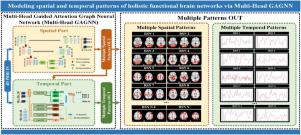Medical Image Analysis ( IF 10.7 ) Pub Date : 2022-06-15 , DOI: 10.1016/j.media.2022.102518 Jiadong Yan 1 , Yuzhong Chen 1 , Zhenxiang Xiao 1 , Shu Zhang 2 , Mingxin Jiang 1 , Tianqi Wang 1 , Tuo Zhang 3 , Jinglei Lv 4 , Benjamin Becker 1 , Rong Zhang 5 , Dajiang Zhu 6 , Junwei Han 3 , Dezhong Yao 7 , Keith M Kendrick 1 , Tianming Liu 8 , Xi Jiang 1

|
Mounting evidence has demonstrated that complex brain function processes are realized by the interaction of holistic functional brain networks which are spatially distributed across specific brain regions in a temporally dynamic fashion. Therefore, modeling spatio-temporal patterns of holistic functional brain networks plays an important role in understanding brain function. Compared to traditional modeling methods such as principal component analysis, independent component analysis, and sparse coding, superior performance has been achieved by recent deep learning methodologies. However, there are still two limitations of existing deep learning approaches for functional brain network modeling. They either (1) merely modeled a single targeted network and ignored holistic ones at one time, or (2) underutilized both spatial and temporal features of fMRI during network modeling, and the spatial/temporal accuracy was thus not warranted. To address these limitations, we proposed a novel Multi-Head Guided Attention Graph Neural Network (Multi-Head GAGNN) to simultaneously model both spatial and temporal patterns of holistic functional brain networks. Specifically, a spatial Multi-Head Attention Graph U-Net was first adopted to model the spatial patterns of multiple brain networks, and a temporal Multi-Head Guided Attention Network was then introduced to model the corresponding temporal patterns under the guidance of modeled spatial patterns. Based on seven task fMRI datasets from the public Human Connectome Project and resting state fMRI datasets from the public Autism Brain Imaging Data Exchange I of 1448 subjects, the proposed Multi-Head GAGNN showed superior ability and generalizability in modeling both spatial and temporal patterns of holistic functional brain networks in individual brains compared to other state-of-the-art (SOTA) models. Furthermore, the modeled spatio-temporal patterns of functional brain networks via the proposed Multi-Head GAGNN can better predict the individual cognitive behavioral measures compared to the other SOTA models. This study provided a novel and powerful tool for brain function modeling as well as for understanding the brain-cognitive behavior associations.
中文翻译:

通过多头引导注意图神经网络(Multi-Head GAGNNs)对整体功能性大脑网络的时空模式进行建模
越来越多的证据表明,复杂的大脑功能过程是通过整体功能性大脑网络的相互作用来实现的,这些大脑网络以时间动态的方式在空间上分布在特定的大脑区域。因此,对整体功能性大脑网络的时空模式进行建模对于理解大脑功能具有重要作用。与主成分分析、独立成分分析和稀疏编码等传统建模方法相比,最近的深度学习方法取得了卓越的性能。然而,现有的用于功能性脑网络建模的深度学习方法仍然存在两个限制。他们要么 (1) 仅对单个目标网络进行建模,而一次忽略整体网络,或者 (2) 在网络建模过程中,fMRI 的空间和时间特征都没有得到充分利用,因此空间/时间精度没有保证。为了解决这些限制,我们提出了一种新颖的多头引导注意图神经网络 (Multi-Head GAGNN),以同时对整体功能性大脑网络的空间和时间模式进行建模。具体而言,首先采用空间Multi-Head Attention Graph U-Net对多个脑网络的空间模式进行建模,然后引入时间Multi-Head Guided Attention Network在建模的空间模式的指导下对相应的时间模式进行建模. 基于来自公共人类连接组项目的七个任务 fMRI 数据集和来自 1448 名受试者的公共自闭症脑成像数据交换 I 的静息状态 fMRI 数据集,与其他最先进的 (SOTA) 模型相比,所提出的多头 GAGNN 在对个体大脑中整体功能性大脑网络的空间和时间模式进行建模方面表现出卓越的能力和普遍性。此外,与其他 SOTA 模型相比,通过提出的多头 GAGNN 建模的功能性大脑网络的时空模式可以更好地预测个体认知行为测量。这项研究为大脑功能建模以及理解大脑认知行为关联提供了一种新颖而强大的工具。与其他 SOTA 模型相比,通过提出的多头 GAGNN 建模的功能性大脑网络的时空模式可以更好地预测个体认知行为测量。这项研究为大脑功能建模以及理解大脑认知行为关联提供了一种新颖而强大的工具。与其他 SOTA 模型相比,通过提出的多头 GAGNN 建模的功能性大脑网络的时空模式可以更好地预测个体认知行为测量。这项研究为大脑功能建模以及理解大脑认知行为关联提供了一种新颖而强大的工具。











































 京公网安备 11010802027423号
京公网安备 11010802027423号